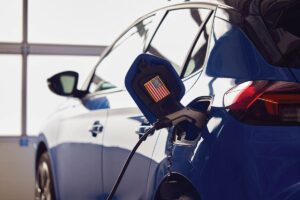Electric vehicles (EVs) are more than just a trend; they’re a shift toward a new era of transportation and energy use.
According to the U.S. Energy Information Administration, data indicates a steady increase in EV adoption, with EVs and hybrid vehicles surpassing 16% of total 2023 U.S. light-duty vehicle sales. Additionally, as of March 2024, 17 states have exceeded 10% of the EV market share, highlighting the regional variations and potential hotspots for EV market penetration. As EVs continue to become more common, electric cooperatives will face new challenges and opportunities to continue providing reliable, affordable energy to consumer-members.
Imagine traffic during rush hour — it’s crowded and slow. Our nation’s electric grid can become just as crowded when everyone charges their EVs at the same time. This major spike in energy use can lead to power outages or expensive updates to our system. But as we prepare for increased electricity demand from EV use, we remain dedicated to solving these challenges and keeping the lights on for everyone.
Smart charging is like a traffic light for electricity — it helps manage the demand for power. Here’s how you can help if you own an EV.
Charge during off-peak hours
Charge your EV when electricity demand is low, such as late at night or early in the morning. This helps to prevent grid overload and saves on your energy bills.
Use delayed charging
Modern EV chargers can wait to charge your car until there’s less demand for power. This helps keep the grid stable and ensures you have power when you need it.
Adopt grid-friendly charging
Some EV chargers can adjust how fast they charge your vehicle based on how much power is available. This helps avoid grid congestion and the need for expensive upgrades.
Managing the EV transition on our electric grid brings many challenges as well as many opportunities for growth and working together. One goal is to help co-op consumer-members understand how EVs and the grid affect each other.
It’s crucial for co-ops to identify and track the EVs within their local networks. Knowing how many EVs are charging on their systems allows for better planning and helps ensure a more stable supply of electricity. When EV charging patterns can be predicted, co-ops can maintain a more efficient and reliable power grid.
Additionally, when local, detailed data is available, the co-op can design EV programs that fit its community’s specific needs, encourage responsible energy use and offer additional cost savings to members. If you’re considering an EV and have questions about home charging, contact your local electric cooperative for guidance.
Photo courtesy of Gerd Altmann, Pixabay










